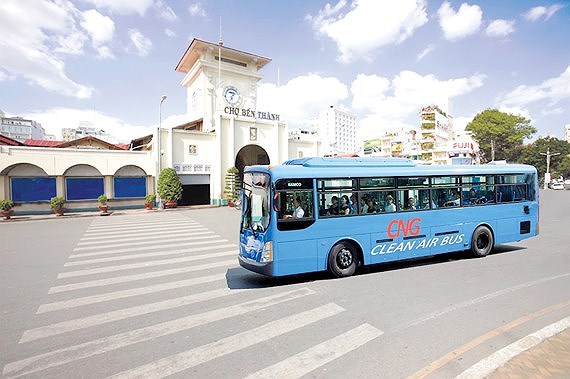[ad_1]
The amount of CO2 in HCM City was estimated at 38.5 million tons, making up about 16 percent of the country. Of the amount, automotive exhausts’ carbon emissions account for 45 percent.

HCMC strives to reduce automotive exhaust’s emission
On the other side, the average amount of CO2 per capita in HCMC is 4.2 tons, highest amongst the big capital cities in the globe, which are committed to solve climate change issue. Accordingly, reduction of automotive exhaust’ carbon emission is a matter of urgency.
According to statistics of the number of vehicles in HCMC, in 2010, the city has around 4.5 million of motorbikes and 420,000 cars; however, in 2017, they are 7.5 million motorbikes and 790,000 cars respectively.
It is forecast that by 2020, the number of vehicles will surge by 30 percent with nearly nine million motorbikes and 800,000 cars. They are discharged CO, CO2, NOx, SOx into the atmosphere through an exhaust pipe, flue gas stack, or propelling nozzle.
As per the Department of Environment and Natural Resources’ studies of air quality in 2017, concentration of CO, CO2, NO2, Coarse dust particles PM10 increased in some localities such as An Suong station, Phu Lam, Cat Lai, Hang Xanh.
Deputy director of the Department Nguyen Thi Thanh My said that the city strived to reduce 70 percent of air pollution caused by exhaust emission in its action plan for the period 2016-2020 yet it has not achieved the goal because the project to assess the number of vehicles and level exhaust emission has not been done.
As if, the city must implement measures to limit personal means of transport and increase public transport.
The Department of Transport was assigned to carry out the project “Increasing public transport along with controlling private vehicles in the city”. So far, the Department has given the green light to investors to replace 1,680 bus fleets with CNG-powered vehicles.
By November 2017, the city has nine electricity vehicles, 101 CNG-powered vehicles and 2,595 public buses. Moreover, some measures such as collecting car parking fee in the metropolitan and collecting environment pollution charges of personal vehicles dependent on emission level have been launched.
Last but not least, the Department will probe the number of secondhand motorcycles and then propose measures to handle these vehicles which are not safe for travelling and for environment.
The government will zone area to restrict personal motorcycles in downtown districts and in traffic gridlock “hot spots” in 2030. Also the city will pilot a special road for cyclists in metropolitan areas.
SGGP
[ad_2]
Source link
